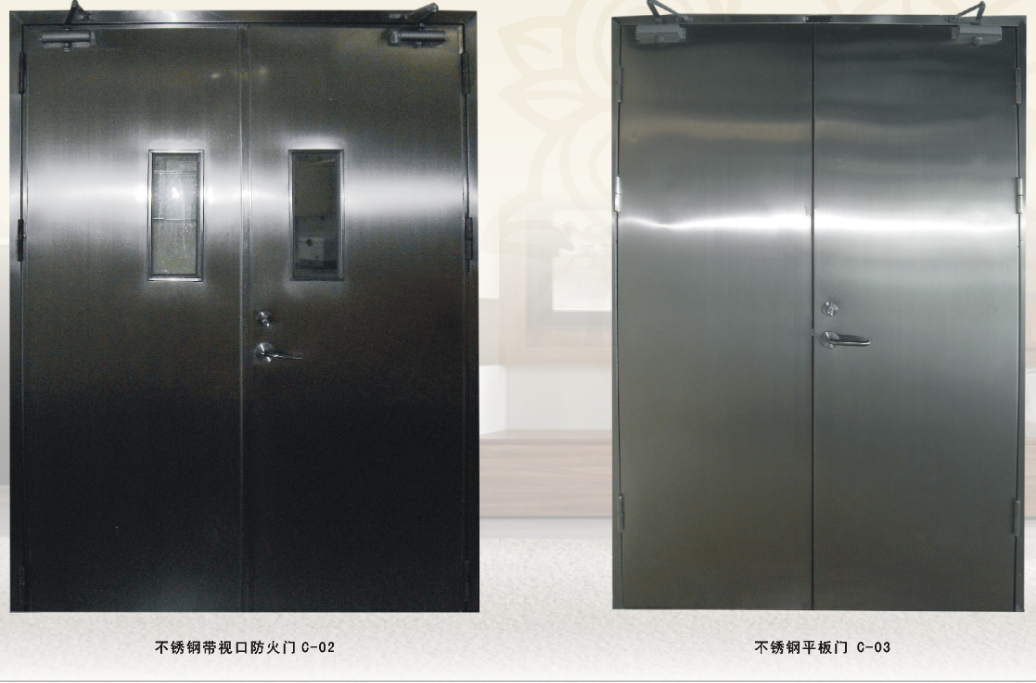An Analysis of the Chinese Fire Door Market: Evolution, Regional Distribution, and Development Trends
Introduction
The Chinese fire door market has witnessed significant changes over the years, driven by evolving fire safety regulations, urbanization, and technological advancements. This paper provides an in-depth analysis of the market’s current state, focusing on the development of fire doors from a historical perspective, regional distribution across major cities, and the impact of recent innovations on market dynamics. Emphasizing key terms like “fire resistance rating,” “integrity,” and “insulation,” this paper also considers the implications of these developments for the future of fire safety in China’s built environment.
Historical Development of the Chinese Fire Door Market

The development of the Chinese fire door market can be traced back to the late 20th century when rapid urbanization led to increased awareness of fire safety. Initially, the market was dominated by basic steel fire doors, which provided essential fire resistance but lacked the advanced features seen in modern products. The introduction of the first comprehensive national standard, GB 12955-1991, marked a significant milestone, setting the foundation for fire door manufacturing and testing.
In the early 2000s, with the revision of the “Fire Protection Law of the People’s Republic of China” and the introduction of updated standards such as GB 12955-2008, the market began to diversify. The new regulations emphasized not only the fire resistance rating but also the importance of insulation and integrity, leading to the development of composite fire doors and the increased use of fire-resistant glazing.
By the 2010s, the market saw a surge in demand for customized fire doors tailored to specific building requirements, such as high-rise buildings and large commercial complexes. The focus shifted towards improving the aesthetic appeal of fire doors without compromising on safety, leading to the adoption of materials like stainless steel and aluminum alloys. The development of Chinese fire doors, particularly the “China fire door,” became synonymous with quality and innovation, setting a benchmark for global standards.
Regional Analysis: Chinese Fire Door Market Distribution Across Chinese Cities

The distribution of fire door demand across China’s urban landscape is influenced by several factors, including economic development, population density, and regional fire safety regulations. Major cities like Beijing, Shanghai, Guangzhou, and Shenzhen represent the largest markets for fire doors due to their high concentration of commercial and residential buildings.
In Beijing, the implementation of strict fire safety codes, particularly in government buildings and historical sites, has driven demand for high-integrity fire doors with superior insulation properties. The city’s focus on preserving cultural heritage while ensuring modern fire safety standards has led to the use of specialized fire doors that blend seamlessly with historical architecture.
Shanghai, with its extensive network of high-rise buildings and commercial complexes, has seen a growing demand for fire doors that offer both fire resistance and acoustic insulation. The city’s role as a financial hub has also led to the development of intelligent fire door systems integrated with building management systems, enhancing both security and fire safety.
In southern cities like Guangzhou and Shenzhen, the market is characterized by the need for fire doors that can withstand the region’s humid climate while providing robust fire protection. The development of corrosion-resistant fire doors with advanced sealing technologies has been a key trend in these areas.
Development Trends and Technological Innovations
Recent years have seen several technological innovations in the Chinese fire door market, driven by the need for higher safety standards and improved functionality. One of the most significant trends is the development of smart fire doors, equipped with sensors and automatic closing mechanisms. These doors are designed to enhance fire compartmentalization and prevent the spread of smoke and flames, particularly in large, multi-story buildings.
The use of fire-resistant glazing has also become more prevalent, allowing for greater transparency and natural light in buildings without compromising safety. This innovation has been particularly popular in modern office buildings and shopping malls, where aesthetics and safety are equally important.
Another key trend is the increasing focus on sustainability in fire door manufacturing. The use of eco-friendly materials and energy-efficient production processes has gained traction, in line with China’s broader environmental goals. For example, the development of fire doors using recycled steel and low-emission coatings is helping to reduce the environmental impact of fire door production.
Case Studies
One notable example of innovation in the Chinese fire door market is the Shanghai Tower, the tallest building in China. The building’s fire safety strategy includes the use of advanced fire doors with a high fire resistance rating, combined with intelligent control systems that manage the doors’ operation during an emergency. These doors are designed to withstand the high wind pressures typical of skyscrapers while providing effective fire compartmentalization.
Another example is the renovation of Beijing’s Forbidden City, where custom fire doors were developed to protect the historical structures. These doors were designed to match the traditional architectural style while providing modern fire protection, ensuring the safety of both the cultural heritage and the visitors.
Understanding the Chinese Fire Door Market: Evolution, Challenges, and the Role of YK Fire Rated Doors
Since its early beginnings in the 1980s, the Chinese fire door market has transformed dramatically—from relying on foreign technology to developing homegrown innovation. As cities continue to expand and fire safety regulations become more stringent, the demand for reliable steel fire doors has grown beyond just public buildings and high-rise apartments. Today, they’re essential components in hospitals, schools, and large-scale commercial complexes.
At the forefront of this transformation is YK Door Industry Co., Ltd., a trusted name in fire rated door manufacturing. We’ve witnessed firsthand how evolving regulations like the newly updated Code for Fire Protection Design of Buildings have elevated the standards of performance and design. These shifts haven’t just changed the way buildings are planned—they’ve made fire rated doors a central requirement in architectural safety.
New Service Standards Reshape Market Expectations
Recently, the China Association for Consumer Product Safety released a groundbreaking group standard that fills long-standing gaps in the after-sales servicing of fire rated doors. The guidelines outline clear benchmarks for service authorization, maintenance capability evaluation, replacement procedures, and end-of-life disposal of fire protection doors and related components. For manufacturers like YK, this framework reinforces our approach to full-lifecycle quality management—ensuring each metal fire door we install can be serviced, upgraded, or replaced responsibly and efficiently.
What Makes a Fire Door More Than Just a Door
A true fire resistant door isn’t just a slab of metal with hinges. It’s a precision-engineered safety system designed to withstand extreme temperatures, block the spread of smoke, and preserve evacuation routes during emergencies. Each component—door leaf, frame, hinges, handles, locks, and closer—must work in harmony. YK’s line of stainless steel fire doors and steel fire resistance doors are engineered with this complexity in mind, ensuring structural integrity even under high-heat conditions.
Chinese Fire Door Market Smart and Sustainable: A New Direction
The industry today is shaped by a mix of product types—steel, wood, and composite fire doors—but the next leap is clear: intelligent, sustainable fire protection. As a forward-looking manufacturer, YK has integrated smart features into several steel fire door models. With embedded IoT sensors and remote monitoring functions, these next-generation doors support early fire detection and centralized safety control. Meanwhile, our use of eco-conscious, halogen-free fireproof materials aligns with China’s “dual carbon” goals and supports green building initiatives.
Still, structural issues remain. Excess production capacity in the low-end segment, reliance on imported materials for high-performance doors, and regional imbalances in demand continue to challenge the market. Bridging these gaps will require more than individual effort—it demands industry-wide collaboration in innovation and supply chain optimization.
Report Insight: The Market’s Next Chapter
According to the 2024–2029 Fire Door Market Forecast by CIConsulting, the China fire door industry is now at a critical inflection point. On one side, favorable government policies and a surge in fire safety awareness are expanding the market. Fire doors are now non-negotiable in building approvals across most regions. On the other, the market is becoming more polarized. Top players are consolidating their influence through mergers and full-spectrum supply chains, while niche manufacturers survive by offering customized fire rated steel doors or project-specific solutions.
At YK, we view this shift as a call to differentiate. We’re investing in fire doors that exceed the 3-hour endurance mark, and we’re experimenting with AI-driven systems for real-time condition reporting. This kind of innovation isn’t optional—it’s how you stay relevant in a market where safety is non-negotiable.
Technology is the Differentiator
For traditional door manufacturers, embracing smart tech and energy efficiency is no longer a trend—it’s a requirement. New materials like nano fire-retardant coatings are raising the bar for fire resistance, and remote monitoring is becoming the norm. Yet, there’s no denying that access to high-grade materials such as specialty fire-resistant glass or UL-compliant stainless steel remains a challenge for smaller firms.
UL fire doors, for example, offer a globally recognized safety benchmark. At YK, our fire doors aren’t just CCC-certified—they’re increasingly built to meet or exceed UL standards, positioning us to better serve international clients and large-scale infrastructure projects.
Geographic Disparities and Emerging Opportunities
There’s also a notable geographic imbalance. Coastal regions like the Yangtze River Delta and the Pearl River Delta have a complete steel fire door supply chain—from raw materials to intelligent locksets—making them industry hubs. YK’s manufacturing operations benefit from this mature ecosystem, enabling us to control quality and reduce costs. Meanwhile, central and western regions still lag due to underdeveloped infrastructure and lower fire safety enforcement.
However, initiatives under the Belt and Road strategy are already shifting this dynamic. As infrastructure spending rises in these regions, so too does the demand for certified, durable fire resistance doors—creating fertile ground for industry growth and YK’s regional expansion.
Between 2025 and 2027, the Chinese fire door market is expected to grow steadily, surpassing RMB 80 billion in market value. Core demand will continue to come from both residential and commercial construction, while the penetration of intelligent fire rated doors—particularly in high-end office spaces and data centers—will boost the overall product value. At the same time, increasingly strict certification protocols aligned with global standards are compelling manufacturers to refine their quality control systems and production lines.
Looking further ahead, from 2028 to 2030, breakthroughs in domestic fire-resistant composite materials and nano-coating technology are likely to reduce reliance on imported components in high-end segments to under 20%. The rise of green, circular economy models—through recyclable materials and modular door systems—aligns with ESG investment trends and will further transform the landscape. Supported by robust demand from Belt and Road nations, China’s fire door exports are projected to grow at an annual rate of 15%, establishing the country as a central player in the global metal fire door and stainless steel fire door supply chain.
Yet, challenges persist. Volatile raw material prices—especially for specialty steel and flame retardants—require manufacturers to enhance supply chain resilience. The shortage of skilled technical talent, particularly in smart systems and new materials, could slow innovation. Compliance costs are rising in parallel with stricter environmental and fire safety laws, potentially accelerating market consolidation.
Against this backdrop, YK Fire Rated Door Manufacturer is positioning itself at the intersection of innovation, quality, and global reach. In the short term, the industry will benefit from urban renewal and the retrofitting of aging buildings. But long-term success depends on mastering three core strategies:
- Smart Fire Systems – Developing interconnected, IoT-based fire safety solutions with embedded sensors and real-time data analytics.
- Sustainable Materials and Processes – Embracing green manufacturing through recyclable components and low-emission production.
- Global Expansion – Building international brand recognition and supply chain integration to serve infrastructure projects worldwide.
Differentiation is no longer optional. For leading brands like YK, that means investing in R&D, participating in international standard-setting, and offering integrated “product + service” solutions. Smaller enterprises, meanwhile, can excel by focusing on niche sectors, such as heritage building retrofits or tailored fire door solutions for specific use cases.
Policymakers must continue to refine industry access standards, foster academic-industrial collaboration, and bolster intellectual property protections to support high-quality growth.
In summary, the Chinese fire door market is transitioning from volume-driven expansion to innovation-led maturity. Through strategic differentiation, technological independence, and global vision, YK Door Industry Co., Ltd. is proud to contribute to building safer, smarter, and more sustainable structures—both in China and around the world.
